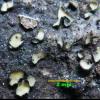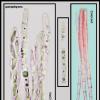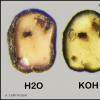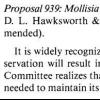
07-12-2025 16:07
Arnold BüschlenHallo, ich habe in einer Moos-Aufsammlung (epiphy

08-12-2025 21:04
Mark Stevens"Hello everyone,I'm relatively new to microscopy (

09-12-2025 12:06
 Andgelo Mombert
Andgelo Mombert
Bonjour,Je recherche l'article concernant Hypobryo

08-12-2025 18:59
 Lothar Krieglsteiner
Lothar Krieglsteiner
.. found by a seminar-participant, I do not know t

08-12-2025 17:37
 Lothar Krieglsteiner
Lothar Krieglsteiner
20.6.25, on branch of Abies infected and thickened

16-03-2014 22:00
Hello,I found this species a few months ago but ha

08-12-2025 13:39
Thomas Læssøehttps://svampe.databasen.org/observations/10572899
Voici une photo macro et une planche d'un disco, soit Mollisia ou Tapesia ?
Merci de votre aide !
Roland
Données :
Substrat : écorce de branche de pin
Spores étroitement ellipsoïdes, parfois un peu courbées, parfois à un septum central difficile à observer, avec 3-4 petites guttules centrales au début, 7-12 x 2-3 µm, 9,1 x 2,4 µm (13 spores), Q = 3,79
Asques à 8 spores bisériées, avec crochet à la base et appareil apical amyloïde, 42-56 x 5-6 µm
Paraphyses cylindriques, progressivement et légèrement élargies vers l'apex, ramifiées à la base, avec 2-3 septa au-dessus de cette ramification, à plusieurs guttules de diamètre différent, souvent plus grosses au tiers inférieur, petites au tiers supérieur, à contenu non jaune en KOH, 61-68 x 2,5-3,5 µm, dépassant les asques d'environ 10 µm
Excipulum ectal en textura globulosa, formé de cellules globuleuses, à paroi épaissie, brunes, jusqu'à 20 µm de diam.
Excipulum ental en textura intricata, formé d'hyphes et de cellules ± polymorphes, hyalines
Hyphes du subiculum cylindriques, parfois ramifiées, septées, à paroi légèrement épaissie, brunes, 3 µm de diam. en moyenne.
Poils marginaux cylindriques, parfois un peu élargis à l'apex, septés, brunâtres, progressivement clavés à globuleux et brun foncé vers la base sur la face externe de l'excipulum, jusqu'à 50 x 4-5 µm
Test au KOH sur hyménophore : réaction jaune à jaune olive.

Tapesia is no longer separated from Mollisia. To identify twe species, we should know whether a yellow sap is exudet when a fragment of the hymenium comes in contact with KOH. Also the width of the subicular hyphae would be interesting.
Mollisia lividofusca seems to be excluded because the subhymenium is not brownish.
Zotto
Subiculum hyphae are 3 µm broad in avery.
Their description is put with the ''données''.
With KOH, we have an olive yellow to yellow reaction.
See photo.
I hope this will be wright.
Merci beaucoup Hans !
Roland

Zotto

http://ibot.sav.sk/icbn/main.htm?
there is an entry that Mollisia is conserved over Tapesia, together with the remark that the two genera are taxonomic (not obligate) synonyms. You can search for "Tapesia" then you find the place. Or go to Appendix IIIa.
Strange enough, there is no reference to articles in that list. I assume that an article in Taxon exists. Mycobank does not help here.
Here is the proposal:
http://openagricola.nal.usda.gov/Record/IND89055616?
http://www.ist-world.org/ResultPublicationDetails.aspx?ResultPublicationId=4c5feb1a9edc4fe9b036564b443ba940?
Maybe someone knows where the final conmservation was published? Andreas wrote in a British forum:
"Tapesia is the older name compared to Mollisia, but a proposal of conservation of Mollisia over Tapesia has been agreed by the Nomenclatural Commitee and so we are free to use the name Mollisia for all Tapesias.
Of course no one is obliged to accept the synonymy and can keep on using the genus Tapesia.?"
Zotto

Andreas has an unpublished phylotree of Mollisia, which I do not have. But I remember that the phylogeny does not depend on the amount of subiculum.
Zotto


Raúl

Zotto
Nicolson D.H. 1993 Report on the status of proposals to conserve and/or reject names (nomina conservanda et rejicienda proposita) published by the end of 1992. Taxon 42 2 435-446.
Mais je n'ai pas le document sous la main. Peut-être ce soir ! A moins que d'ici là quelqu'un puisse récupérer le pdf via le site JSTOR.
Amitiés, Guy

Si tu l'obtiens, je suis intéressé!
Raúl
Nicolson D.H. 1993 General Committee report 5. Taxon 42 2 431-434.
Bonne lecture

Raúl

ca correspond mieux a ce que j'appell M. cinereoolivacea pour le moment. Je ne sais pas avec certitude, que c'est le même que le M. cinereoolivascens Svrcek, car je n'ai pas obtenu le typus deja.
Les caractères de cet éspèce trés commune (chez moi) est un hymenium qui devient creme à jaunâtre quand il sêche lentement, des spores en peu plus grande que M. cinerea et avec des petits guttules (contenu huileux 1 dans la scale de Zotto) et - important! - un excipulum qui devient olivâtre-verdâtre quand on ajoute KOH. C#est peut-être la raison, pourqui ton apothecium devient olivâtre a KOH, mais on ne voit pas de juice jaunâtre.
Je cherche depuis deux ans dans le locus typicus de Mollisia cinerea une collection correspondent avec ma conception de M. cinerea - mais je trouve surtout cet M. cinereoolivacea .....
amicalement,
Andreas
La seule espèce que je trouve dans votre clé sur les Mollisia de 2006, qui pousse sur le bois et dont les spores semblent plus petites que les nôtres, et qui est placée en remarques est :
spores 6-10(11) x 1-1,7 µm, à contenu huileux inconnu, peut-être < 1 ... Mollisia cinereoolivascens
Est-ce exact ?
Amitiés, Roland






 Nicolson-Taxon-42-431-434-1993-0001.pdf
Nicolson-Taxon-42-431-434-1993-0001.pdf